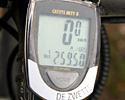
Recently on Cyclingnews.com |
The bikes of Hell: Peter Van Petegem's Davitamon-Lotto's Ridleys, April 11, 2006Clean machineAnthony Tan continues scoping out the bikes of Paris-Roubaix as they get the post-race jet-wash treatment
It seems that one way to keep your bike clean at Paris-Roubaix is to go like stink for 259km, because Peter Van Petegem's Ridley is surprisingly dirt-free when we catch up with the Davitamon-Lotto team after the race, and just before De Peet's and his team-mates' bike get some hose action. Even the white Selle San Marco saddle looks pretty fresh. Van Petegem himself is less happy after he and two other riders were disqualified for going round the barriers at a rail crossing, depriving the tough Belgian of another Paris-Roubaix podium place. But while that decision is being debated at the finish, Davitamon's mechanics are snaking long hoses out to their team area outside the Roubaix velodrome and going through the rinse/soap/rinse procedure that's the standard method for cleaning up bikes after a race. Davitamon's Ridleys have survived the day well. Disqualifications aside, seven of the team's riders finished, and Tom Steels' DNF was due to a crash not bike failure. Van Petegem and his team-mates were aboard relatively conventional-looking aluminium frames, rather than their usual Damocles carbon fiber rigs.Though we weren't able to confirm the details, the frames look like custom jobs - or at least custom back ends with lengthened chainstays to help alleviate the Paris-Roubaix pounding.
Another special feature of these Ridleys is the wheels: Campagnolo record hubs are laced to box-section rims with 32 good old stainless steel spokes. Modern aerodynamic, low-spoke count wheels may have advantages in some situations, but when what matters most is utter reliability, teams still reach for tried-and-true technology. Van Petegem's bike has a couple of other interesting personal features. To get behind the bottom bracket into a position to crank out the power all day long, De Peet uses an FSA K-Force Light seatpost in its maximum setback version. FSA makes three versions of this two-bolt post, with different amounts of setback so that riders can tailor the fit of their bikes as necessary. FSA also supplies Davitamon's OS140 aluminium stems. Perched on top of the seatpost is another old reliable design, a Selle San Marco Rolls saddle. It's obvious that this is a component chosen for comfort not light weight, given the enormous range of options from San Marco in featherweight seats, but when you're going to park your bum for over six hours and blast over 52km of cobbles, comfort takes precedence. PhotographyFor a thumbnail gallery of these images, click here Images by Anthony Tan/Cyclingnews.com
|





